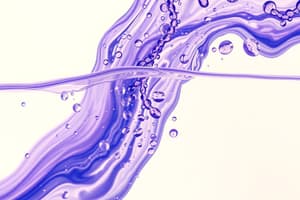Podcast
Questions and Answers
What is the expected change in cardiac output during hydrotherapy?
What is the expected change in cardiac output during hydrotherapy?
- Decrease to 5.0 L/min
- Increase to 6.5 L/min
- Increase to 7.0 L/min
- Increase to 8.6 L/min (correct)
How does hydrotherapy primarily affect the renal system?
How does hydrotherapy primarily affect the renal system?
- Decreases sodium excretion
- Restricts blood flow to kidneys
- Decreases creatinine clearance
- Increases diuresis through increased blood flow (correct)
What is a physiological effect of thermotherapy?
What is a physiological effect of thermotherapy?
- Induce local vasoconstriction
- Decrease blood flow
- Relieve pain (correct)
- Decrease elasticity of muscle
Which condition is a contraindication for hydrotherapy?
Which condition is a contraindication for hydrotherapy?
What percentage does the rib cage circumference decrease due to hydrostatic pressure?
What percentage does the rib cage circumference decrease due to hydrostatic pressure?
Which of the following is a therapeutic use of hydrotherapy?
Which of the following is a therapeutic use of hydrotherapy?
What effect does cooling therapy have on tissue metabolism?
What effect does cooling therapy have on tissue metabolism?
How does hydrotherapy influence blood flow in the musculoskeletal system?
How does hydrotherapy influence blood flow in the musculoskeletal system?
Study Notes
Cardiovascular System
- Hydrostatic pressure increases venous return, leading to increased atrial pressure.
- Cardiac output increases significantly, reaching 8.6 L/min at 86 bpm with increased stroke volume.
- Systemic vascular resistance decreases.
Pulmonary System
- Hydrostatic pressure reduces rib cage circumference by approximately 10%.
- Vital capacity decreases by 6-9%.
- Pulmonary blood flow increases.
- Total work of breathing increases by 60% when water reaches neck level.
Renal System
- Increased blood flow leads to enhanced creatinine clearance, sodium excretion, and potassium excretion.
- This, in turn, increases diuresis.
- Hydrotherapy with full-body immersion is recommended for edema management in nephrotic syndrome and cirrhosis patients.
Musculoskeletal System
- Resting blood flow increases by 100% to 225%.
- Enhanced muscle blood flow and oxygen delivery occur.
- Waste product removal is facilitated.
- Muscle elasticity increases.
- Buoyancy reduces joint load.
- Water's velocity allows for resistance training.
Thermotherapy
- Relieves pain.
- Enhances muscle elasticity.
- Promotes relaxation.
- Hyperemia due to increased blood flow accelerates metabolic rate, generating more heat.
Cooling Therapy
- Slows metabolic rate, decreasing metabolite production and heat generation.
- Reduces pain.
- Induces local vasoconstriction.
- Decreases cellular metabolism, minimizing edema.
- Offers deeper tissue cooling effects.
- Apply cooling therapy at least 72 hours after trauma.
Therapeutic Uses of Hydrotherapy
- Vasodilation or vasoconstriction modulation.
- Wound care (non-open wounds).
- Water-based exercise.
- Pain management.
- Edema control using hydrostatic pressure and renal function modifications.
Indications of Hydrotherapy
- Subacute or chronic soft tissue injuries.
- Muscle contractures.
- Scar formation
- Osteoarthritis.
- Subacute or chronic rheumatoid arthritis.
- Post-fracture patients.
- Open wounds.
- Burns with intact thermal sensation.
- Pressure ulcers.
- Muscle spasms.
- Tension.
- Anxiety.
- Muscle weakness due to disuse.
- Muscle weakness from central nervous system conditions (e.g., hemiplegia).
- Peripheral nervous system pathologies (e.g., polyneuropathy).
Studying That Suits You
Use AI to generate personalized quizzes and flashcards to suit your learning preferences.
Related Documents
Description
Explore the impacts of hydrostatic pressure on various body systems including cardiovascular, pulmonary, renal, and musculoskeletal. This quiz covers how hydrostatic pressure affects blood flow, respiratory capabilities, and muscle function, providing key insights for understanding human physiology. Test your knowledge on the physiological adaptations related to immersion and its therapeutic applications.




